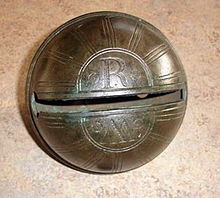

Crotal bells (Greek 'crotalon' – castanet or rattle) are various types of small bells or rattles. They were produced in various pre-Columbian cultures. In Europe they were probably made from before the early Middle Ages; though many founders cast bells of this type, the Robert Wells bell foundry of Aldbourne, Wiltshire, produced the largest range. The first medieval designs came in two separate halves into which a metal pea was introduced and the two halves were then soldered or crimped together. Somewhere around 1400 they were cast in a single piece with a ball of metal inside.[1]
Crotal bells, also known as rumble bells, were used on horse-drawn vehicles before motor vehicles were common. They were often made of bronze with a slot cut down the side. These bells were used to warn other users of horse-drawn vehicles (mostly on country roads) that another vehicle was approaching. On smaller vehicles, they were hung on a small leather-and-iron harness bracket above the horse's collar; on larger vehicles, such as delivery wagons, they were driven into the wooden frame of the wagon.